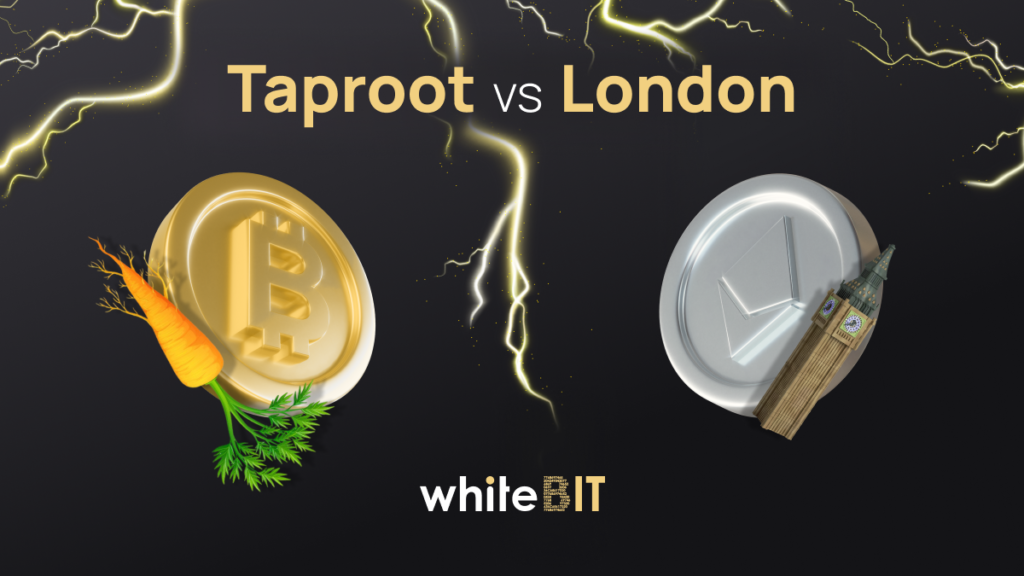Taproot and London: Comparing the Leading Blockchain Upgrades

Content
Digital assets have become increasingly common in finance and in modern people’s lives. There are whole infrastructures based on blockchains, and payments in crypto are already widespread. However, the load on the network grows along with its popularity. That is why upgrades are crucial to keep blockchains efficient.
Today, we will compare two major upgrades of the competing networks: Taproot (Bitcoin) and London (Ethereum). In this article, we will discuss their peculiarities, similarities, and differences.
London
It is a hard fork of the Ethereum network that was launched on the 5th of August, 2021. Network scalability issues were long overdue, while the NFT and DeFi hype made the problem even more acute.
The hard fork included five improvement proposals: EIP-1559, 3554, 3529, 3198, and 3541. The London upgrade was mainly targeted at changing the transaction fee mechanism. Besides, it was to pave the way for the network migration from PoW to PoS.
Base fee
The main change is the new transaction pricing mechanism. Before the upgrade, users used to specify the gas price themselves, and miners selected transactions with the highest fees because those turned into rewards for added blocks.
EIP-1559 implies a base fee, which is a minimum payment for including the transaction into a block. It changes for each block, depending on the network demand. If a block becomes more than 50% full with transactions, the base fee increases, and vice versa. This method allows smoothing fee fluctuations and makes them more predictable for users.
Preparing for the Ethereum 2.0
The hard fork enables the future shift to the Proof of Stake consensus algorithm. The London upgrade has been labeled as “deflationary”, as it affects the tokenomics and pushes miners to switch to staking.
The base fee gets burned to slow down the emission. Miners only receive the priority fee, an extra payment for the priority a user can make to speed up the transaction processing. Besides, the EIP-3554 update delays the Ethereum “difficulty bomb” till December 2021. After it “explodes”, mining will become several times harder and way less profitable.
Taproot
The upgrade to the Bitcoin network was implemented on the 14th of November, 2021. A soft fork was intended to optimize the protocol scripts, as well as enhance the privacy, security, and capacity of the network. Taproot utilizes the Schnorr signature scheme and MAST technology to achieve these goals.
Schnorr signature scheme
The technology allows combining the signatures of multiple transaction participants into one. It benefits both users’ confidentiality and the overall capacity of the network. Schnorr signatures allow hiding the info about the transaction type, participant number, keys, and so on. Besides, key aggregation speeds up transaction processing while decreasing its size and fee.
MAST
Merkelized Abstract Syntax Tree (MAST) is a technology thanks to which all spending conditions are hashed individually and included in a Merkle tree. Only the condition that is met is shown.
This allows saving the blockchain storage and contributes to creating more complex scripts. At the same time, Schnorr signatures help keep the MAST structure hidden.
Find out more about Taproot in our previous articles: article 1, article 2.
The differences and similarities of Taproot and London
Undoubtedly, both upgrades are intended to optimize the corresponding blockchains. However, the BTC and ETH networks have different structures, meaning they face different issues and offer their own ways to solve them.
Backward compatibility
The London upgrade is a hard fork, which is a change to the network that is not compatible with the previous software versions. Taproot is a soft fork. For example, the implementation of Schnorr signatures does not replace ECDSA in the Bitcoin network – both schemes can coexist.
Scalability
Both upgrades influence scalability. However, it is a priority for Taproot, while London solely prepares the ground for Ethereum 2.0, a solution designed to address scalability directly. Besides, this upgrade will make the networks even more different from each other: Eth2 implies a complete shift to the PoS algorithm, meaning that ETH mining will be gone for good.
Transactions
Both upgrades make transactions faster and more accessible. Nevertheless, if London concerns all Ethereum users, Taproot mainly makes a difference for the participants of more complex transactions with aggregated signatures.
Conclusion
London and Taproot are designed to enhance their blockchains and create better conditions for users. London is primarily intended to change the fee pricing mechanism, fight the ETH inflation, and create conditions for the future shift to PoS. Taproot aims to improve the BTC scripts. This will positively impact the overall confidentiality of the network, boost the efficiency of transaction processing, lower fees, and reduce the amount of data stored in the blockchain.








